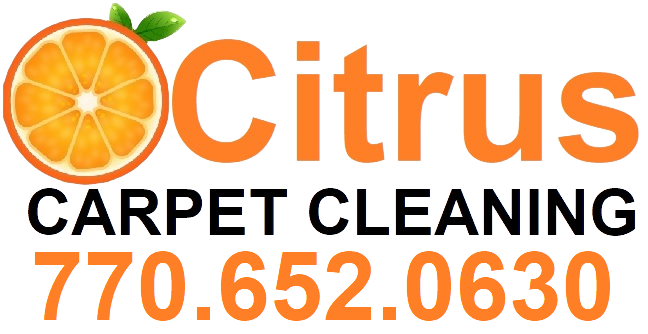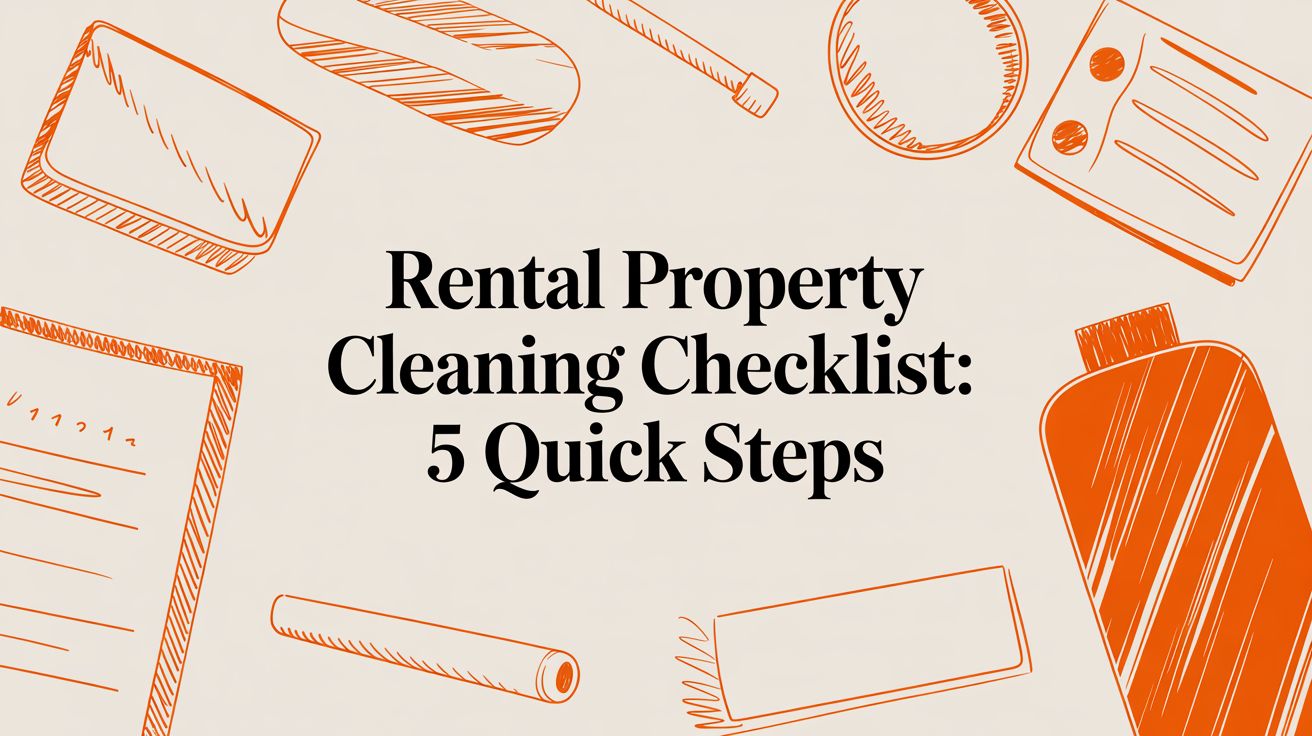A successful tenant turnover hinges on more than a quick wipe-down; it demands a meticulous, systematic approach that restores a property to its peak condition. For landlords and property managers, especially those in areas like Buford, GA, a pristine unit is a powerful tool. It not only attracts higher-quality tenants faster but also minimizes costly vacancies and protects the long-term value of your investment. This is the definitive rental property cleaning checklist designed to elevate your turnover process from a simple chore to a strategic asset management task.
In this comprehensive guide, we move beyond basic tidying to detail the 10 critical zones requiring professional-level attention. We will break down the deep-seated grime, hidden maintenance issues, and overlooked details that accumulate between tenancies. From deep cleaning carpets to address pet odors to degreasing kitchen appliances and ensuring HVAC systems are pristine, each step is crucial. Following this checklist ensures you deliver a safe, welcoming, and valuable rental experience. Let's dive into the actionable steps that will set your property apart, streamline your turnover, and maximize profitability.
1. Deep Clean Carpets and Rugs
Carpets and area rugs act as filters, trapping dirt, dust, pet dander, and allergens deep within their fibers. While regular vacuuming is essential, it only removes surface-level debris. A professional deep clean between tenants is a non-negotiable step in any comprehensive rental property cleaning checklist, as it restores the carpet’s appearance, eliminates odors, and improves indoor air quality for the incoming resident.
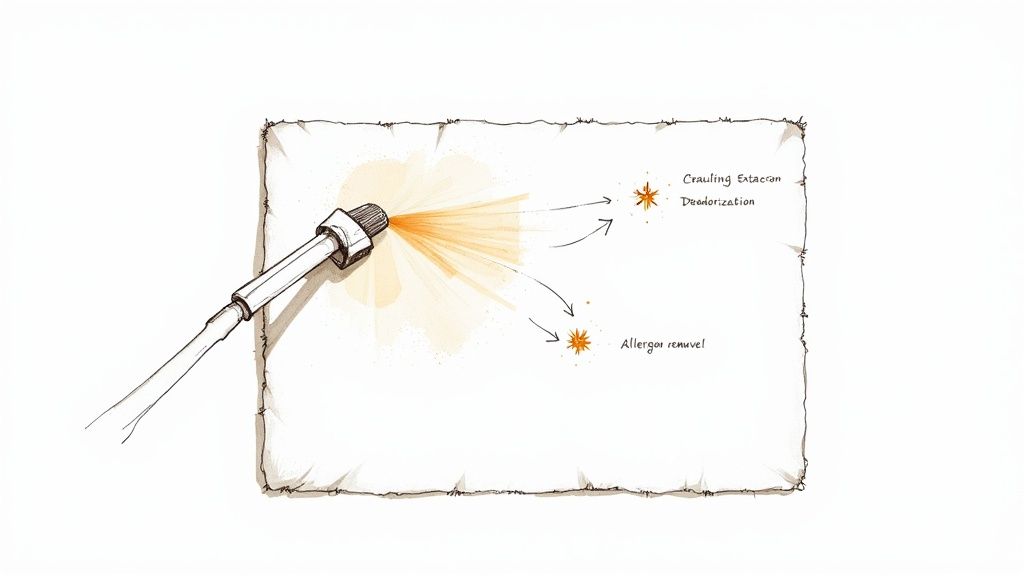
This process typically involves hot water extraction, often called steam cleaning, which uses high-pressure hot water to agitate the carpet fibers and dissolve the embedded grime. A powerful vacuum then extracts the water, dirt, and allergens. For landlords, this method not only creates a welcoming environment but also protects a significant investment by extending the carpet's lifespan. A pristine, fresh-smelling carpet makes a powerful first impression on prospective tenants.
Implementation and Best Practices
To ensure the best results, follow these practical steps:
- Timing is Key: Schedule the deep cleaning after all other cleaning, repairs, and painting are complete but at least 2-3 days before the new tenant moves in. This allows ample time for the carpets to dry completely, preventing mold or mildew growth.
- Hire Professionals: While DIY rental machines are available, professional services certified by organizations like the IICRC use superior equipment and cleaning solutions for a more thorough and effective result. You can learn more about professional deep carpet cleaning to understand the difference.
- Document Everything: Take "before" and "after" photos of the carpets and any specific stains. This documentation is invaluable for security deposit discussions and tenant records.
2. Kitchen Deep Clean and Degreasing
The kitchen is the heart of any home and a focal point for prospective tenants. A comprehensive deep clean that removes grease buildup, food residue, and stains is a critical part of any rental property cleaning checklist. Over time, cooking oils and food particles create a sticky film on cabinets, backsplashes, and appliances that regular wiping cannot remove. A thorough degreasing ensures the space is sanitary, looks well-maintained, and is move-in ready.
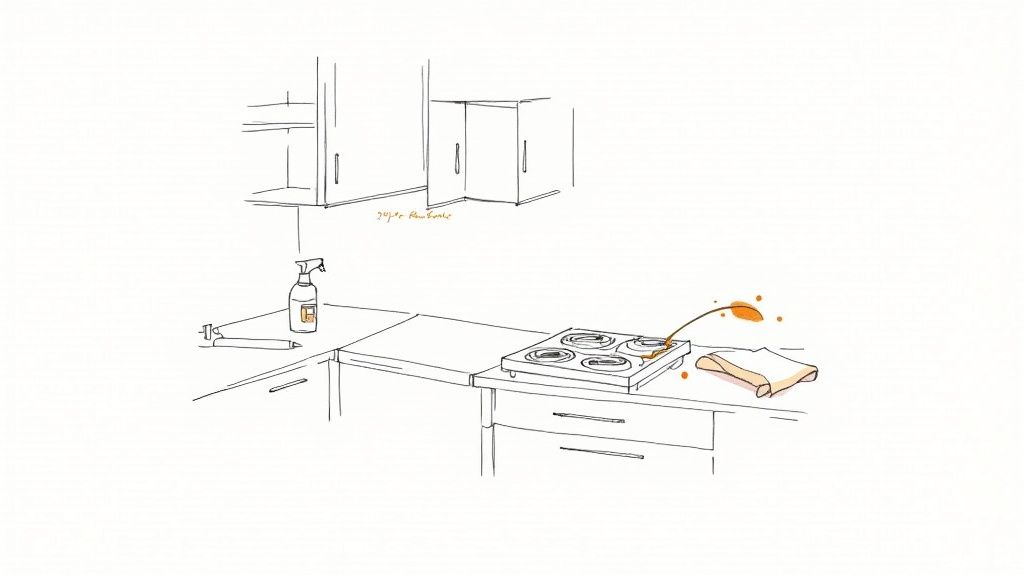
This process involves using specialized cleaning agents, such as alkaline degreasers, to break down tough, oily grime. For landlords, presenting a sparkling clean kitchen directly impacts a tenant's perception of the property’s overall upkeep and can justify rental rates. A pristine, grease-free kitchen not only feels more hygienic but also prevents lingering odors from previous tenants, creating a fresh start for the new occupants.
Implementation and Best Practices
To achieve a professional-level clean, follow these specific steps:
- Use the Right Products: Choose a powerful alkaline degreaser for heavy grease on stovetops and vent hoods. For mineral deposits on sinks and faucets, an acidic cleaner is more effective.
- Allow Dwell Time: For maximum effectiveness, spray the degreaser on surfaces and let it sit for 10-15 minutes before wiping. This allows the chemical agents to dissolve the grease, reducing the need for harsh scrubbing.
- Clean Top-to-Bottom: Always start with the highest surfaces, like the tops of cabinets and the vent hood, and work your way down. This method prevents dirt and residue from contaminating already cleaned lower surfaces. You can explore a detailed apartment turnover cleaning checklist for more room-by-room specifics.
- Finish with Microfiber: Use clean, dry microfiber cloths for the final wipe-down. They are excellent at trapping remaining residue without leaving behind lint or streaks on countertops and appliances.
3. Bathroom Sanitization and Mold Prevention
The bathroom is a critical area in any rental property cleaning checklist, as its condition directly impacts tenant health and satisfaction. Due to constant moisture, it is a prime breeding ground for bacteria, mildew, and mold. A thorough sanitization process that goes beyond a simple wipe-down is essential to eliminate harmful germs, prevent stubborn stains, and address potential mold issues before they escalate into costly remediation problems.
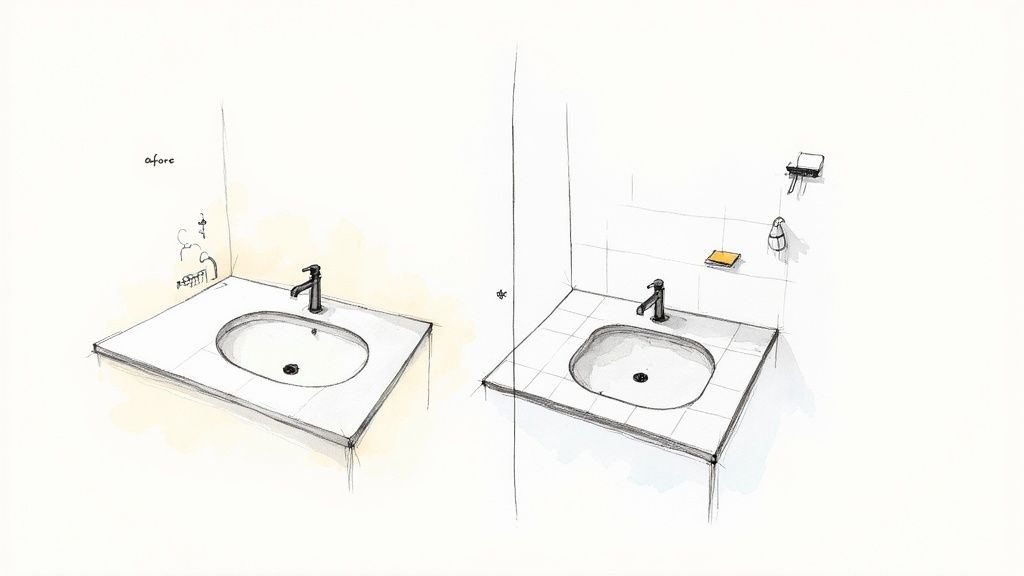
This intensive cleaning involves disinfecting every surface, from the toilet bowl and sink basin to the shower tiles and grout lines. Using effective, industry-recognized products like those from Clorox or CLR ensures the removal of soap scum, hard water stains, and unseen pathogens. Proper sanitization not only creates a hygienic space for the incoming tenant but also protects the property owner from potential health code violations and tenant complaints related to mold or unsanitary conditions.
Implementation and Best Practices
To guarantee a pristine and healthy bathroom environment, follow these key steps:
- Use Appropriate Cleaners: For tough mold and mildew on grout or caulking, a solution of one part bleach to ten parts water is highly effective. For hard water stains and mineral deposits on fixtures, a dedicated calcium, lime, and rust remover will restore shine.
- Focus on Ventilation: Ensure the bathroom exhaust fan is clean and operational. Advise new tenants to run the fan for at least 30 minutes after every shower to significantly reduce moisture buildup and inhibit mold growth.
- Inspect Hidden Areas: Carefully check for signs of mold or water damage under sinks, around the base of the toilet, and behind tiles or caulking. Addressing small issues early prevents widespread, expensive damage.
- Scrub Grout and Recaulk: Dirty grout can make an entire bathroom look aged and unclean. Scrub all grout lines thoroughly. If caulking around the tub, shower, or sink is peeling, discolored, or moldy, remove it completely and apply a fresh, clean bead.
4. Wall and Baseboard Cleaning and Touch-ups
Walls and baseboards are some of the most visible indicators of a property's maintenance level. Scuffs, fingerprints, dust, and marks accumulate over time, particularly in high-traffic areas, and can make a clean space feel neglected. Addressing these surfaces is a crucial part of any rental property cleaning checklist because it directly impacts a prospective tenant's perception of the home's overall condition and cleanliness.
This process involves thoroughly wiping down all wall and baseboard surfaces to remove grime, followed by precision touch-up painting where cleaning isn't enough. For landlords, this relatively low-cost effort yields a high return by making the entire unit look brighter, fresher, and well-cared-for. A flawless wall surface enhances natural light and provides a truly blank canvas, allowing new tenants to envision themselves living in the space.
Implementation and Best Practices
To restore your walls and baseboards efficiently, follow these best practices:
- Clean Before Painting: Always start by washing walls with a gentle solution, like a mixture of water and mild dish soap, using a soft cloth. This removes grease and dirt, ensuring the new paint adheres properly. A magic eraser can be effective on stubborn scuffs, but test it on an inconspicuous spot first.
- Document Paint Colors: Keep a detailed record of the exact paint colors, brands, and sheens used in each room. Storing this information simplifies future touch-ups, guaranteeing a perfect match and avoiding unsightly, mismatched patches on the walls.
- Focus on High-Impact Zones: Concentrate your efforts on high-traffic areas like hallways, entryways, and around light switches and doorknobs. These spots show the most wear and will make the biggest difference when refreshed. After completing any touch-ups, ensure you follow safe paint disposal methods.
5. Floor Cleaning and Waxing
Beyond carpets, hard surface floors like hardwood, tile, laminate, and vinyl require specialized care to maintain their appearance and durability. A simple mopping often leaves behind residue and fails to address scuffs, scratches, or dullness. Professional floor cleaning and waxing are vital components of a rental property cleaning checklist, ensuring these high-traffic surfaces are protected, hygienic, and visually appealing for incoming tenants.
This process involves more than just cleaning; it's about restoring the floor's protective layer and shine. For materials like VCT or sealed hardwood, this means stripping old wax, deep cleaning the surface to remove embedded dirt, and applying fresh coats of wax or sealant. Proper maintenance not only impresses prospective renters with gleaming floors but also safeguards the landlord's investment by preventing costly floor damage and prolonging its lifespan.
Implementation and Best Practices
To ensure your hard floors are pristine and protected, follow these steps:
- Identify the Flooring Type: Different materials require specific care. For instance, you should avoid excessive water on hardwood and laminate. Using the wrong products, like an acidic cleaner on natural stone, can cause irreversible damage.
- Use pH-Neutral Cleaners: To prevent damage to the floor's finish, always opt for pH-neutral cleaning solutions recommended by manufacturers like Bona for hardwood or Zep for commercial-grade flooring. This is a safe bet for most sealed surfaces.
- Prep Before Cleaning: Always dust mop or vacuum the floor with a soft-bristled attachment before any wet cleaning. This removes abrasive debris like sand and dirt that can scratch the floor during the mopping or waxing process.
- Apply Wax Correctly: When waxing floors, apply multiple thin, even coats rather than one thick layer. Allow each coat to dry completely before applying the next for a durable, professional-looking finish.
6. Window and Glass Surface Cleaning
Crystal-clear windows and glass surfaces dramatically brighten a rental property, maximizing natural light and creating an impression of pristine cleanliness. Grimy, streaked windows can make an otherwise spotless unit feel neglected and dim. Including a thorough window cleaning in your rental property cleaning checklist is essential for showcasing the space at its best and improving curb appeal, which is often a deciding factor for prospective tenants during a showing.
This task involves more than just spraying and wiping the glass. A complete cleaning addresses the interior and exterior panes, window sills, frames, and tracks where dirt and debris accumulate. For spotless transparency, learn how to professionally clean your windows and achieve a streak-free shine on your windows to make the property look well-maintained and inviting. Clean windows signify attention to detail, reassuring new tenants that the property is well-cared-for.
Implementation and Best Practices
To ensure a flawless finish, follow these actionable tips:
- Clean Tracks First: Use a stiff brush or an old toothbrush to loosen debris in the window tracks. A vacuum with a crevice tool can remove the loosened dirt, followed by a wipe-down with a damp cloth.
- Use a Squeegee: For large glass surfaces like patio doors or picture windows, a high-quality squeegee is the best tool for a streak-free result. Overlap each stroke by about an inch for even coverage.
- Inspect Screens: While cleaning, check window screens for any rips, holes, or damage. Repairing or replacing them is a small cost that prevents pests and maintains the property's integrity.
- Consider Professionals for Height: For multi-story properties or hard-to-reach exterior windows, hiring a professional service is the safest and most effective option to ensure a consistent, high-quality clean.
7. HVAC and Air Filter Replacement
A property's heating, ventilation, and air conditioning (HVAC) system is crucial for tenant comfort and satisfaction. Overlooking its maintenance is a common but costly mistake. Clogged filters and dirty coils not only circulate dust, allergens, and pollutants throughout the home but also force the system to work harder, increasing energy consumption and the risk of expensive breakdowns. Including HVAC servicing in your rental property cleaning checklist is essential for ensuring good indoor air quality and protecting your investment.
Proper maintenance involves more than just swapping out a filter. It includes inspecting the entire system, cleaning the evaporator and condenser coils, and ensuring all components are functioning efficiently. For landlords, this proactive approach prevents emergency repair calls in extreme weather, demonstrates a commitment to tenant well-being, and can significantly lower utility costs passed on to residents. A well-maintained HVAC unit is a key feature that makes a property more attractive and livable.
Implementation and Best Practices
To integrate HVAC care into your turnover process effectively, follow these steps:
- Schedule Professional Servicing: Arrange for a qualified HVAC technician to inspect and service the unit between tenants, ideally before the new lease begins. This establishes a clean baseline for the new resident.
- Upgrade Air Filters: Use high-efficiency filters with a MERV rating of 11-13. These capture smaller particles like mold spores and pet dander, providing superior air quality compared to standard fiberglass filters.
- Educate and Empower Tenants: Provide new tenants with a clear filter replacement schedule (e.g., every 90 days) and simple instructions. Supplying the first few filters can encourage compliance.
- Clean Vents and Registers: As part of the turnover clean, wipe down all air vents and registers to remove accumulated dust, which also helps maintain system cleanliness and complements other tasks like cleaning ceiling fans and light fixtures.
- Keep Meticulous Records: Document all inspections, cleanings, and repairs. This log is vital for warranty claims, asset management, and demonstrating proper upkeep.
8. Door and Hardware Cleaning and Replacement
Doors, handles, locks, and hinges are among the most frequently touched surfaces in any home, accumulating grime, fingerprints, and germs over time. A crucial part of any rental property cleaning checklist involves thoroughly cleaning and inspecting this hardware between tenants. This step goes beyond simple aesthetics; it ensures proper functionality, security, and hygiene for the incoming resident, addressing critical high-contact points often overlooked.
This process involves wiping down all door surfaces, polishing metal hardware like handles and hinges, and testing every lock and latch. For landlords, this is also a prime opportunity to assess wear and tear. A sticky lock or a loose handle not only presents an inconvenience but can also become a security liability. Addressing these issues proactively prevents future maintenance calls and demonstrates a commitment to tenant safety and a well-maintained property.
Implementation and Best Practices
To properly address doors and hardware, follow these guidelines:
- Rekey All Locks: As a standard security measure, rekey or replace all exterior door locks after a tenant moves out. This guarantees that previous tenants or anyone they shared a key with can no longer access the property.
- Inspect and Test Functionality: During the turnover, open and close every door, checking for squeaky hinges, proper latching, and smooth lock operation. Tighten any loose screws on handles, hinges, or locksets.
- Document Condition: Take clear photos of all doors and hardware after cleaning and repairs. This documentation is vital for the move-in inspection and can be used to justify any security deposit deductions for damages beyond normal wear and tear.
- Consider Upgrades: If hardware is outdated or damaged, consider upgrading to more durable and modern options. Companies like Schlage offer reliable locksets, and investing in smart locks can streamline tenant access and improve security monitoring.
9. Appliance Cleaning and Maintenance
Appliances are high-value amenities that significantly impact a tenant's daily life and their satisfaction with a rental property. Simply wiping them down is insufficient for a turnover. A thorough deep clean and functional check of every appliance, from the refrigerator to the washing machine, is a critical part of any rental property cleaning checklist. This process prevents costly repairs, extends the lifespan of expensive equipment, and ensures they operate efficiently and safely for the new resident.
This comprehensive step involves more than surface cleaning. It means degreasing ovens, descaling dishwashers, cleaning refrigerator coils for energy efficiency, and clearing dryer vents to prevent fire hazards. Properly maintained appliances contribute to lower utility bills for the tenant and fewer maintenance calls for the landlord. A sparkling, well-functioning set of appliances communicates a high standard of care and justifies the property's rental value.
Implementation and Best Practices
To ensure appliances are in top condition for the next tenant, follow these key steps:
- Create a Detailed Checklist: Address each appliance individually. This includes cleaning the oven interior and cooktop, emptying the refrigerator and washing all shelves, running a cleaning cycle in the dishwasher with a product like Affresh, and clearing the lint trap and vent duct on the dryer.
- Perform Functional Tests: After cleaning, run a short cycle on the dishwasher and washing machine to check for leaks or operational issues. Test all oven and stove functions to confirm they are working correctly.
- Document and Educate: Provide new tenants with a brief guide on proper appliance use and simple maintenance they can perform, such as regularly cleaning the dishwasher filter. Keep a log of professional maintenance and inspections for your records.
10. Trash Removal and Debris Cleanup
A thorough trash and debris cleanup is a foundational step in any rental property cleaning checklist, setting the stage for all subsequent deep cleaning tasks. This goes beyond simply emptying wastebaskets; it involves the complete removal of all abandoned items, accumulated junk, and general clutter left behind by the previous tenant. Failing to address this can create health hazards, attract pests, and send a clear signal of poor property management to potential renters.
This process ensures the property is a blank slate, free from any remnants of the prior occupancy. Handling this systematically prevents deeper cleaning efforts from being wasted and addresses potential safety and liability issues. A property cleared of all trash and unwanted items immediately looks more spacious, cared for, and ready for its next resident, significantly improving its appeal during viewings.
Implementation and Best Practices
To manage trash removal efficiently and professionally, follow these steps:
- Document and Dispose: Before removing anything, photograph all items left behind by the tenant. This documentation is crucial for handling security deposit claims related to disposal costs or abandoned property disputes.
- Order of Operations: Schedule junk removal before any deep cleaning begins. There's no sense in cleaning floors or surfaces only to have them dirtied again by hauling out old furniture and trash bags.
- Consider Professional Help: For large amounts of debris or bulky items like furniture and mattresses, hiring a professional junk removal service like 1-800-Got-Junk can save significant time and physical effort. They have the equipment and knowledge for proper disposal.
- Check Local Regulations: Be aware of your local municipality's rules for bulk waste disposal, recycling, and handling specific items like electronics or hazardous materials to ensure compliance and avoid fines.
10-Point Rental Property Cleaning Comparison
| Service | Implementation Complexity 🔄 | Resource Requirements ⚡ | Expected Outcomes ⭐📊 | Ideal Use Cases 💡 | Key Advantages ⭐ |
|---|---|---|---|---|---|
| Deep Clean Carpets and Rugs | Moderate–High 🔄 — professional equipment and technique | Hot-water extractor, trained crew, drying 24–48h; $300–$600 ⚡ | Removes embedded soil/allergens; restores appearance and life span ⭐📊 | Between tenants; odor/stain recovery; deposit disputes 💡 | Deep stain/allergen removal; improves air quality ⭐ |
| Kitchen Deep Clean and Degreasing | High 🔄 — chemical knowledge and detail work | Commercial degreasers, PPE, 3–4 hrs labor; $150–$300 ⚡ | Grease-free surfaces; pest risk reduction; improved presentation ⭐📊 | Move-ins, heavy-use kitchens, showings 💡 | High visual impact; prevents infestations ⭐ |
| Bathroom Sanitization and Mold Prevention | High 🔄 — mold risk and safety protocols | Disinfectants/bleach, PPE, ventilation; possible remediation costs $200–$400 ⚡ | Eliminates bacteria/mold risk; code compliance; healthier environment ⭐📊 | High-moisture units; visible mold; health/code concerns 💡 | Reduces health liability; prevents costly remediation ⭐ |
| Wall and Baseboard Cleaning and Touch-ups | Low–Moderate 🔄 — simple cleaning, occasional paint work | Magic erasers, touch-up paint, labor; $75–$200 ⚡ | Removes scuffs/marks; improves perceived maintenance and curb appeal ⭐📊 | Cosmetic refreshes between tenants; high-traffic areas 💡 | Low-cost visual improvement; quick results ⭐ |
| Floor Cleaning and Waxing | Moderate–High 🔄 — varies by flooring type | Floor machines, sealants/wax, curing 24–48h; $200–$500 (deep); refinishing $1,500–$3,000 ⚡ | Protects floors, extends lifespan, enhances valuation ⭐📊 | Hardwood/tile maintenance, pre-listing, high-traffic units 💡 | Long-term protection; raises property value ⭐ |
| Window and Glass Surface Cleaning | Low–Moderate 🔄 — simple but exterior access adds complexity | Squeegees, cleaners, ladders/scaffold for exterior; $50–$150 ⚡ | Brighter interiors; high visual impact; increased tenant satisfaction ⭐📊 | Showings, between tenants, seasonal cleaning 💡 | Low cost with immediate visual payoff ⭐ |
| HVAC and Air Filter Replacement | Moderate–High 🔄 — technical for ducts/coils | Filters (MERV11–13), tools, pro service for ducts; $20–$500 ⚡ | Improved air quality, energy savings, fewer breakdowns ⭐📊 | Pre-move-in inspections, allergy-prone units, seasonal tune-ups 💡 | Health and efficiency gains; prevents expensive failures ⭐ |
| Door and Hardware Cleaning and Replacement | Low–Moderate 🔄 — cleaning simple; rekeying technical | Cleaning supplies, locksmith services for rekey/replace; $50–$500 ⚡ | Enhanced security and hygiene; better first impressions ⭐📊 | Turnovers, security updates, after tenant changeover 💡 | Improves safety/presentation; reduces disease transmission ⭐ |
| Appliance Cleaning and Maintenance | Moderate 🔄 — some require technicians | Cleaners, techs for repairs, coil/vent tools; $150–$300 ⚡ | Reliable operation; fewer emergency repairs; longer appliance life ⭐📊 | Kitchens/laundry rooms, pre-move-in checks, high-use units 💡 | Prevents breakdowns; preserves amenity value ⭐ |
| Trash Removal and Debris Cleanup | Low–Moderate 🔄 — labor and logistics heavy | Labor, dumpsters/junk removal, disposal fees; $100–$500 ⚡ | Clears space for repairs/cleaning; reduces pests and liability ⭐📊 | Move-outs with clutter, abandoned items, hoarding cases 💡 | Essential prerequisite step; enables accurate maintenance ⭐ |
Transform Your Turnover into a Competitive Advantage
Moving beyond a simple to-do list, this comprehensive rental property cleaning checklist serves as a strategic framework for success. By systematically addressing every detail from degreasing kitchen appliances to sanitizing bathroom fixtures and replacing HVAC filters, you are doing more than just preparing a space for the next tenant. You are actively building your reputation, safeguarding your investment, and creating a highly desirable product in a competitive rental market.
A pristine, move-in-ready unit is a powerful marketing tool. It communicates professionalism and care, justifying your rental rates and attracting higher-quality tenants who are more likely to treat the property with respect. This meticulous attention to detail minimizes early maintenance requests, reduces tenant disputes over pre-existing conditions, and ultimately shortens vacancy periods, directly boosting your bottom line.
Key Takeaways for Proactive Property Management
Recapping the essential pillars of an effective turnover clean, remember to focus on these high-impact areas:
- Go Beyond the Surface: Tasks like deep carpet cleaning, wall and baseboard washing, and interior appliance maintenance are what separate a standard clean from a professional turnover.
- Prioritize Health and Safety: Proper bathroom sanitization, mold prevention, and ensuring clean air through HVAC maintenance are non-negotiable for tenant well-being and your liability.
- Consistency is Your Brand: Implementing this checklist as a standard operating procedure for every turnover ensures a consistent, high-quality experience for every new resident, strengthening your brand as a premium landlord.
Turning Your Checklist into Action
The true value of this rental property cleaning checklist is realized through consistent implementation. Don't view it as a one-off task but as an integral part of your property management cycle. Consider creating a digital version that you or your team can check off during each turnover, adding photos to document the condition of the unit before the new tenant moves in. This creates a clear record of quality and accountability.
While many of the items on this list can be handled in-house, tasks like deep carpet cleaning require specialized equipment and expertise to achieve the best results. For landlords and property managers in Buford, GA, this is especially critical. A professionally cleaned carpet not only looks and smells fresh but also has its lifespan extended, protecting a significant asset within your property.
Ultimately, adopting this rigorous cleaning protocol transforms a tedious chore into a powerful competitive advantage. You are not just cleaning a rental; you are curating a superior living experience that fosters tenant loyalty, protects your investment, and maximizes your return. Make excellence your standard, and your properties will stand out as the benchmark for quality in your market.
Ready to ensure your floors make the best first impression? For a deep, residue-free clean that dries in hours, not days, trust the experts at Citrus Carpet Cleaning Buford. Contact us today to see how our low-moisture, citrus-based solutions can revitalize your rental property’s carpets and impress your next tenants.
